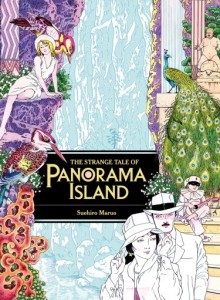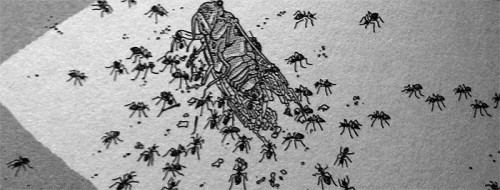 THE STRANGE TALE OF PANORAMA ISLAND
THE STRANGE TALE OF PANORAMA ISLAND
by Suehiro Maruo
Last Gasp, 2013
274 Pages / $24.95 Buy from Last Gasp
I first encountered Suehiro Maruo via the hyper-violent/erotic, aka “ero-guro” collection that Creation Books put out in 2001, ULTRA-GASH INFERNO. It’s a slim volume of short manga narratives, all focused on some sort of extremity. Despite the subject matter, Maruo carried a sense of poetry through the excess, and the resulting combination brought about similar feelings to that which I had first experienced reading the fiction that set me down my life’s trajectory, fiction such as Bataille’s Story of the Eye or Bernard Noel’s Castle of Communion. I became a dedicated fan.
Next encounter–the only other book of Maruo’s available in translation at the time–was Mr. Arashi’s Amazing Freak Show. A more developed narrative (developed in the sense that it is a book-length narrative, instead of only giving itself a few pages to breathe). It rooted itself in the earlier parts of the 20th century, which allows a certain suspension of disbelief necessary to the development of the plotting (which eventually goes off the deep end regardless).
Now, a number of years later–and after a significant waiting period between the announcement of publication and the actual publication of the book (which, I should note, should not be considered a fault)–Maruo’s most developed single-volume narrative yet has become available in English– The Strange Tale of Panorama island.
…Panorama Island is based on a novel by Edogawa Rampo,–a homonymic approximation of “Edgar Allen Poe” of course–a Japanese author who wrote tales of crime, mystery, and the bizarre. Rampo’s stories pop up repeatedly as inspiration for countless Japanese genre films. Kinji Fukasaku’s Black Lizard (aka Kurotokage), is based on on a novel of the same title, Blind Beast and it’s huge anatomical sculptures come from Rampo’s mind, the pinku film Watcher in the Attic, Hisayasu Sato’s Caterpillar, Shinya Tsukamoto’s Gemini–the list goes on and on. In 1994 a sort of “creative non-fiction” biopic about Edogawa Rampo was released, Rampo (The Mystery of Rampo in the US)–of course, “creative non-fiction” is used loosely here, as there’s little of Rampo’s actual life in the film other than one of his narratives.
Maruo’s book, Rampo’s novel, follow the exploits of a writer who can’t deal with contemporary (the narrative is set at the end of the 1920s) life & devises a plot to create the Utopian island that he’s always dreamed of–no matter the cost. Eventually, he does, and the island is an idyllic daydream of European gardens & sculptures, young beautiful men and women who are both acrobats and sexually insatiable, panoramas that refuse reality and leave it temporarily behind, and at the most, a testament to decadence and beauty. Split in to a somewhat uneven 2/3rds & 1/3rd structure, the book focuses on the process of getting to the building of the Utopian island, and then the existence of the utopian island.
The meat, of course, comes at the island–a beautiful, mysterious testament to a sycophantic vision. And it’s also through the depiction of the island that Maruo’s beautiful art blooms so to speak–hugely detailed undersea worlds viewed through a glass tube, ornate architectural details of the romantic ruin in simulacra, water flowing off of huge cliffs as divers cliff dive into the water below, all the while populated by statuary and flora; a sensual feast of food and drink offered to all those at the island, the pure bacchanal of the orgiastic infinitude that utopia conquers.
But, thankfully, there’s more to this book than pretty pictures. While Maruo’s art–his understanding of momentum and movement through panels–is the driving force behind the volume, the narrative provides the necessary skeleton to allow the art to go wild. While the narrative of Mr Arashi’s Amazing Freak Show felt thin to me, working to adapt an accomplished novelist here gives Maruo the structure and edge needed to maintain the story for almost 300 pages. Nothing feels forced or unnecessary here, and certainly nothing feels slow. We are saved from a deep psychological delving into our protagonist’s mind, as Maruo recognizes that when working within the media of manga (or, that is to say, “illustrated narrative”), that sort of thing just bogs down the momentum, renders visuals moot. There is nothing but momentum in this book until those few moments–often full 2-page spreads–dedicated to giving space for the reader to enter this beautiful dreamed utopia.
Maruo is smart, too, choosing to quote great decadent/symbolist monuments within his work. The denouement comes upon the revelation of a replica of Bocklin’s “Isle of the Dead,” gardens quote archetypal French gardens, with their geometric symmetricality, the panoramas create the world into a flower. At other points in the work Maruo makes use of a developed sense of visual metaphor to develop the affect the visual story holds. In one instance ants swarm the dead body of a sovereign grasshopper immediately after men speak of swarming over a dead-man’s fortune. This is a method that another favorite graphic artist of mine, Guido Crepax, uses repeatedly throughout his work. It’s something that the graphic medium specifically can pull off well, as when used in language it can bog down movement with unnecessarily heavy metahpor.
Last Gasp did a wonderful job in the publication of this volume–the book is large, thick, with a beautiful full-color cover, yet somehow the book is incredibly light for it’s size & page-count. It makes holding the book for the duration it takes to read the entire narrative non-problematic, comfortable. Each individual page is also reproduced beautifully, not muddied or low-contrast like lesser manga publications can be, but rather perfectly edging out to the borders of the page, pure blacks & whites (well, slightly paler than white on the page-stock used, but this serves more of an elegance than any sort of muddying)–a gorgeous volume.
Tags: comix, japanese comics, last gasp, manga, sitting on ruins, suehiro maruo, utopian dreams


Cool. More please.
tinyurl.com/l3cselt